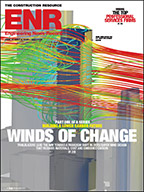In a trade-off, the simpler methods were deliberately developed to render more conservative results than the more complex procedures, says Ronald O. Hamburger, a senior principal in the San Francisco office of structural consultant Simpson Gumpertz & Heger and chairman of the ASCE/SEI 7-16 main committee. “The different answers are not an indication of a lack of safety,” he says.
Simiu also is concerned about inconsistencies in the standard's specification of wind pressures on rooftop equipment. “There is a large difference between design pressures” for roofs at 59 ft and 61 ft, when there isn't in reality, he says.
The engineer further objects to the provisions for wind-tunnel test procedures. “[They] lack sufficient specificity and can lead to different estimates of design wind effects,” says Simiu.
Not only that, he is concerned with an “unprecedented profusion of tables [when] convenient, user-friendly computational tools are universally available.” The tables may be unnecessary and may lead to errors in interpretation, he says.
During development of the 2010 edition, there were no actionable proposals that would have allowed the committee to adopt new or alter existing provisions in the areas addressed by Simiu, says Reinhold. This might have been because the standard was rushed to meet a deadline for inclusion as a reference standard in the 2012 version of the model International Building Code. Without the rush, “valuable changes” would not have been adopted until the next IBC, Reinhold says. A bigger problem is a “woeful” lack of federal funding for wind research to support change, he adds.
Simiu and four NIST colleagues have co-authored a critique on the wind-loads design standard. The paper, currently in draft form, will be posted for public comment, likely by Oct. 7, on www.nist.gov. Once finalized, it will become an official NIST document, says Simiu.
For the 2016 cycle, the engineer plans to submit a change proposal on the maps and possibly on reducing the number of design methods. Work should begin on the 2016 standard “immediately” to avoid a rush at the end, says Simiu.
Hamburger says time is the true test of ASCE/SEI 7: “Structures designed in accordance with the standard have generally performed well. That is the best way to judge whether it is adequate.”





Post a comment to this article
Report Abusive Comment